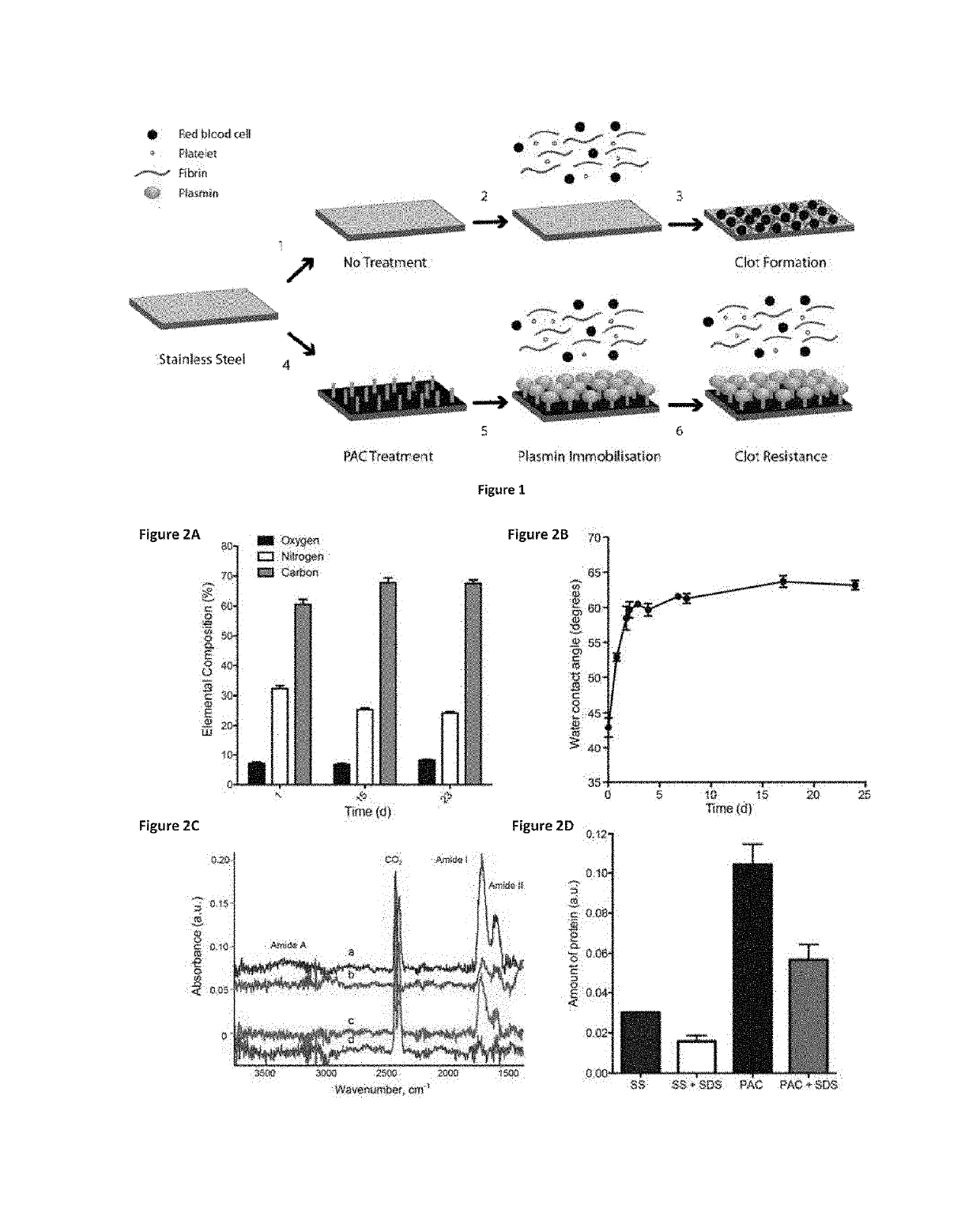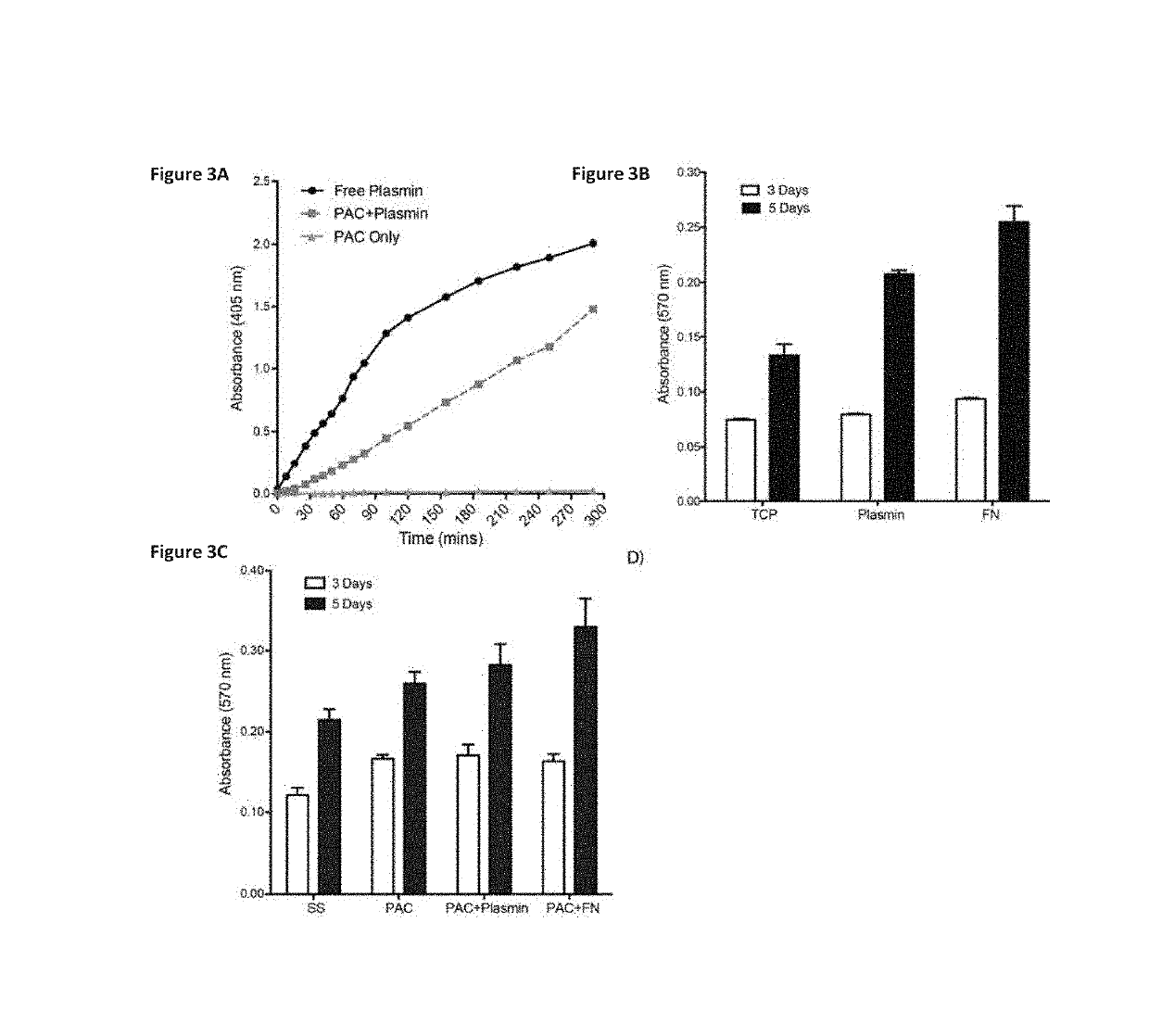Medical devices with reduced thrombogenicity
a medical device and thrombogenic technology, applied in the field of biomaterials, can solve the problems of increasing the thrombogenicity of dapt, the inability to effectively use biomaterials in clinical vascular applications, and the inability to meet the requirements of thrombogenicity, so as to achieve robust application, and reduce the risk of thrombosis.
- Summary
- Abstract
- Description
- Claims
- Application Information
AI Technical Summary
Benefits of technology
Problems solved by technology
Method used
Image
Examples
example 1
Immobilization of Plasmin to PAC
[0084]Materials and Methods
[0085]Reagents: All reagents were purchased from Sigma-Aldrich, St Louis and used without further purification unless otherwise noted. Human umbilical vein endothelial cells (HUVECs) were harvested enzymatically from umbilical cords. Endothelial cells from passages 2-4 were used.
[0086]Sample Preparation:
[0087]The substrates were 316L, stainless steel foil (SS) 25 μm thick (Brown Metals), or 3.0×10 mm 316LVM stainless steel stents (Laserage, Calif., USA). Plasma-activated coating on 316L stainless steel (PAC) surfaces were generated from acetylene in, argon mixed with nitrogen. Stainless steel stents were imaged with a Zeiss EVO 50 scanning electron microscope. Samples were incubated with increasing concentrations of plasmin (0.1, 1.0 and 10 μg) in PBS at 37° C. overnight and washed in PBS prior to use.
[0088]Surface Characterization:
[0089]The contact angle between PAC and de-ionized water was measured using a Kruss contact an...
example 2
y Bound Plasmin Retains Bioactivity
[0093]Materials and Methods
[0094]Covalent Attachment:
[0095]Samples were washed with water to remove salt and dried prior to accumulation of spectra using a Digilab FTS7000 FTIR spectrometer fitted with an attenuated total reflection (ATR) accessory with a trapezium germanium crystal at incidence angle of 45°. To obtain sufficient signal / noise ratio and resolution of spectral bands, 500 scans with a resolution of 1 cm−1 were taken. Difference spectra were used to detect changes associated with the presence of plasmin, and analysis carried out. Unbound protein was removed by aspiration and the surfaces were washed with PBS. Non-covalently bound protein was removed by SDS-washing. Samples were treated with 5% (w / v) SDS for 1 h at 80° C. Following the SDS treatment, samples were washed with PBS and distilled water.
[0096]Bioactivity Assay:
[0097]The enzymatic activity of plasmin was monitored using a commercially available kit. One unit of activity is de...
example 3
Cell Attachment and Proliferation
[0100]Materials and Methods
[0101]Endothelial Cell Interactions:
[0102]For proliferation assays, HUVECs (20,000 cells / mL) were plated in 24-well plates for 3 and 5 days. Attachment and proliferation of cells to and on plasmin-coated wells was analyzed in comparison to tissue culture plastic alone and to wells coated with fibronectin (10 μg / well). Cells were quantified at 3 and 5 days post-seeding using the MTT (3-[4,5-dimethylthiazol-2-yl]-2,5 diphenyl tetrazolium bromide) assay according to manufacturer's instructions. Dimethyl sulfoxide (DMSO) was used to dissolve insoluble formazan crystals, and the absorbance at 540 nm was measured using a spectrophotometer (Biorad).
[0103]Results
[0104]After 3 days of incubation, cell numbers on TCP, plasmin and fibronectin (FN) were not significantly different (FIG. 3B). At day 5, cell proliferation on plasmin was 56.40±3.2% higher than TCP alone (p<0.001), but remained statically less than then FN positive control...
PUM
| Property | Measurement | Unit |
|---|---|---|
| water contact angle | aaaaa | aaaaa |
| thick | aaaaa | aaaaa |
| thick | aaaaa | aaaaa |
Abstract
Description
Claims
Application Information
 Login to View More
Login to View More - R&D
- Intellectual Property
- Life Sciences
- Materials
- Tech Scout
- Unparalleled Data Quality
- Higher Quality Content
- 60% Fewer Hallucinations
Browse by: Latest US Patents, China's latest patents, Technical Efficacy Thesaurus, Application Domain, Technology Topic, Popular Technical Reports.
© 2025 PatSnap. All rights reserved.Legal|Privacy policy|Modern Slavery Act Transparency Statement|Sitemap|About US| Contact US: help@patsnap.com



